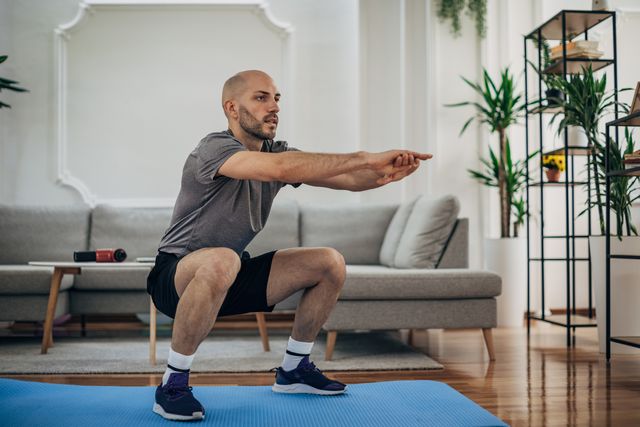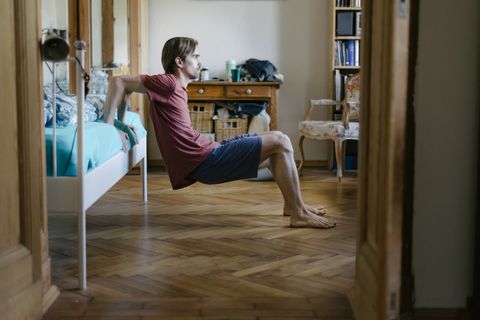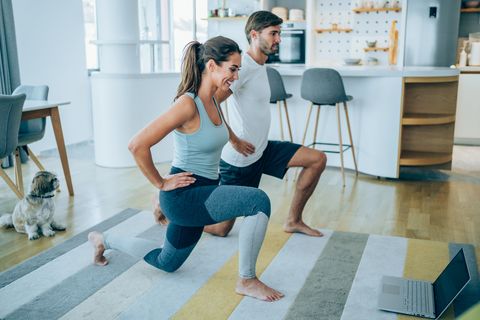While there's plenty of reason to build your workout around gym machines, weight plates, barbells and other fitness apparatuses out there, hopping right into using these devices can be a little intimidating. Some might require unique and difficult movements for proper effectiveness. Some might be too expensive to warrant a purchase. Some might be flat-out miserable to use (looking at you, treadmills).
But despite the existence of all this fitness equipment, there are other ways to train.
Bodyweight training can be a great way to work up a sweat without all the bells and whistles. These simple exercises require virtually no equipment and can be done anywhere at any time. We spoke with Aaron Swenson, a founding coach at FightCamp and NASM-certified trainer, to outline some of the best bodyweight exercises for a proper, effective regimen, but first, it can be worthwhile to understand some of the perks that come with this training discipline.
The Benefits of Bodyweight Training
You already have everything you need.
The big selling point of bodyweight training is right there in the name: Your body serves as the resistance in training, so there's no extra purchases required to get started — outside of maybe a new pair of gym shoes or snappy new workout wardrobe. You don't need to drain your bank account buying a ton of resistance bands or bulky home gym equipment. With bodyweight training, your gym is always accessible.
There are additions and accessories that can make your workouts more effective or comfortable if you'd prefer to add some gear to your get-up. Yoga mats can be great for creating a plush surface to rest your joints, back and feet across varying movements, and Swenson highly recommends including a pull-up bar if you have the means, as well. "I think pull-ups and back rows are super important because a lot of times when we’re doing bodyweight movements, it’s really hard to get the posterior chain," he states. "The lats and the back are so underutilized, especially with strikers, because everything’s so anterior that you end up just kind of hunching forward."
But for the most part, you are the workout equipment.
It can help lay the foundation for heavier training in the future.
If you're new to working out, facing down a weighted back squat, deadlift or other heavy exercise can seem daunting, and the added resistance doesn't combine well with a lack of form. "The benefit of bodyweight training is that it’s really important to start there to build a solid foundation, building up the tendons and the ligaments that support your muscles and your bones and your spine," says Swenson.
Starting with bodyweight exercises before progressing into weighted movements or machines let you introduce yourself to a whole host of different exercise types with less potential risk of injury. Creating that skill set before tacking on extra resistance can help your joints and muscles assimilate to the work and strain more easily, while also establishing correct form in the process. So, when you do venture into the gym and approach a new machine, you'll be better prepared to correctly (and safely) move the newfound totals.
It's simple to build a workout that suits your specific needs.
While we're all accustomed to walking around with our bodyweight on a daily basis, moving, stretching and bending it in different positions might not be as intuitive for everyone. A push-up or sit-up might seem simple, but if you're switching from a sedentary lifestyle to a more active one, even those movements can come with some stress that might be too much to overcome.
Bodyweight exercises can be scaled and altered to make the movements more achievable as you learn and grow in the discipline. Trouble with back squats? Try just sitting down in a chair for a set number of reps and sets. Push-ups giving you strain? Elevate your hands on a couch, end table or wall and perform the exercise without as much resistance. As you learn and progress, your muscles and tendons will become more accustomed to these actions. You're still moving and training, which is the ultimate goal with any regimen.
How to Build a Bodyweight Exercise Routine
As with any training regimen, you have to start by deciding what you're aiming for. "If it’s like a sedentary person who hasn’t really been trained that much, I’m going to put them on a much different plan than I would a professional athlete," Swenson says.
For general newcomers, it can be ideal to plan for 3–4 training days per week, which can give your body some time to recover in-between sessions. Swenson also recommends signing up for a guided app service like FightCamp or employing the help of a personal trainer. This extra support for your training can help better ensure you're performing each movement with the correct form. "You don’t know what you don’t know, so if nobody ever points that out to you, you’re not going to look for it, and if you continually do those same patterns, you’re going to have muscle imbalances which could lead to injury," he says.
If you are confident in your abilities and have a good grasp of the movements required, Swenson still recommends recording yourself during training or working out in front of a mirror to give feedback on your form from time to time. It's a continual progress that you should constantly monitor, because as Swenson notes, our bodies are always looking to adapt movements for the most efficient pathways possible, "The body knows all the cheat codes." Even after you've been training for weeks, months and years, your form can falter at times, which will require some readjustment on occasion.
In terms of reps and sets per regimen, Swenson typically employs the Optimum Performance Training Model for new clients. This training blueprint moves you through varying levels of intensity and rep ranges targeting different factors associated with growth and progression.
"I start them on the stabilization phase where you’re holding a lot of planks — front planks, side planks, reverse planks, hip thrusts, kind of seeing where we’re at there, building up all those stabilizing muscles. Then from there, [we] go into muscular endurance where you’re starting to rep it out more, like 10–15 reps with push-ups, squats, lunges. All of those basic movements," Swenson says.
"And then, once you’re kind of solid there, then we move into the more explosive power phase where you’re working jump switch lunges, burpees, box jumps. Stuff like that that’s really explosive, working the fast-twitch muscles. And then once you’re there, then we kind of mix and match constantly, so the body reacts to novelty."
The exercises you choose can be up to you or your personal trainer, and there's no wrong answer. Swenson, for example, recommends pairing a push movement, like a push-up or tricep dip, with a pull movement like a glute bridge. Others might want to structure a session solely on either upper body or lower body modalities. In the end, make sure to choose a workable rep range across a handful of exercises, like the ones listed below.
Swenson also recommends building a routine that has you moving in all directional planes of motion. Front-to-back, side-to-side and twisting movements can help engage the posterior chain more and keep the body on its toes, eliminating any of those potential cheat codes and resulting in more progress and performance.
The Best Bodyweight Exercises
Plank
The plank is a great core exercise and also serves as an effective starting position for a handful of other bodyweight movements. To complete a plank, lie prone on the floor with your elbows bent. Next, raise your frame and core off the ground into a suspended position, supported by your forearms and feet only while maintaining a straight back. Squeeze your scapula together as if you're trying to hold a pencil in-between your shoulder blades, and engage your core to help maintain that straight profile. Hold for a set amount of time, depending on your ability.
Push-Up
Yes, we all know the push-up, but it's worth revisiting its mechanics because it's easy to do poorly.
Begin this exercise in a raised plank position, supporting your body through your hands and feet. Your hands should be directly underneath your shoulder blades, and your back should be straight. Then, look straight down at the ground and lower yourself to the floor, making contact at your nose, chest and knees. Push yourself back up to ascension, breathing out during your incline. Pause, and then repeat for the desired amount of reps.
Sit-Up
Another well-known core-targeting movement, the sit-up begins with you lying on your back with your knees bent and feet flat on the floor. Your hands should rest at either side of your head in a comfortable position. To complete a sit-up, bend your hips and waist to raise your upper body off the ground. Look straight ahead and keep your chest open as you raise toward your knees. Lower your torso back down to the ground, pause and repeat.
Squat
Begin your squat in a standing position with your feet just outside shoulder width. Next, push your butt back and hinge at the hips like you're sitting down in a chair. Once you've descended to the desired height, push through your feet and return to a standing position. You can also extend your arms straight out during this movement to add a sort of counterweight for better balance.
Swenson notes to keep your back straight throughout the entire movement and try to keep your knees from caving inward during ascension. "My favorite cue is on the way up, imagine that a piece of paper is sitting underneath your feet and you’re trying to tear the piece of paper outward as you come up," he says.
Burpee
Burpees might seem like a complicated movement, but in reality, the exercise can be broken down into four main parts. Begin in a standing position with your legs shoulder width apart. Next, perform a squat by hinging at the hips and kicking your butt back while maintaining a straight back. At the bottom position, kick your legs straight back to go into a raised plank position, supporting yourself at the feet and hands. Spring your feet back into your frame, shifting your weight to your feet, stand up and repeat.
Glute Kickback
This bodyweight exercise begins with you on all fours with your hands directly underneath your shoulder and knees under your hips at a 90-degree angle. Next, slowly raise and drive your leg backward, squeezing your glute as you lift. Maintain a flexed foot throughout the movement while keeping your hips square to the ground. Lower your leg back to the starting position, pause and then perform the same movement with the other leg. Alternate between each leg for your prescribed amount of repetitions.
Mountain Climber
Start your mountain climber from a raised plank position, similar to a push-up with your hands right beneath your shoulders. Squeeze your scapula together and keep your back straight throughout this exercise. Next, according to Swenson, "bring your right knee to your chest, bring it back to a back plank and then vice versa."
"As you do this, I want you to imagine a bottle of water on your back and you can’t let the water bottle spill," he adds. "You want to keep that back as straight as a board. Once you can stabilize, feel free to pick up the pace, inside out as you breathe and engage your core, syncing your breath with your reps."
Step-Up
For this movement, you'll need an elevated surface that can sturdily house your frame without collapsing. A stool or stair can be sufficient, but other platforms like plyo boxes are fine as well. Begin standing in front of your platform with your arms at your sides. Step up with one leg and land on the platform so that your raised knee is directly over the middle of your foot — your leg should make a 90-degree angle at the knee, resembling a crisp L. Next, drive through your elevated front foot, extending the knee to raise your body to the platform. Bending at the same knee, slowly lower your frame back down to the starting position. Alternate between each leg using the same motion for your desired rep range.
Glute Bridge
Swenson states to begin a glute bridge by lying on your back with your knees raised and feet shoulder-width apart, similar to your starting sit-up position. Next, "I want you to push through your heels and squeeze your butt at the top. Big range of motion here, and once you get to the top, I want you to hold it for me," he says. Then, disengage your glutes, lower your hips back down and repeat for the set amount of reps.
Swenson also stresses that your glutes should feel taut at the top end of your glute bridge, so make sure to try and achieve that firmness with each completed repetition. "As my coach always said, you want apples not apple sauce, so make sure those glutes are engaged and right and tight," he adds.
Superman Stretch
Lie on the floor in a prone position with your arms and legs fully extended. With your head in a neutral setting looking forward, slowly lift your arms and legs off the ground, resembling your favorite superhero flying through the sky. Engage your core and glutes as you hold this position for a set amount of time, breathing controllably throughout the duration. Lower your arms and legs back to the starting position, pause, rest and repeat.
Tricep Dip
Start in a reverse plank position with your chest facing the ceiling and your hips high. Your palms should be flat on the ground, stacked underneath your shoulder with your fingers pointing toward your toes, according to Swenson. "From here, bend at the elbows. Your hips are going to come down as well, and then you’re going to extend with a big range of motion," he adds.
"If you want to make this movement harder, bring your feet further away from your midline. The further your feet are from your midline — from your hips — the harder this movement gets because there’s going to be more weight in your arms, so you can kind of play with that angle."
Broad Jump
Before getting into this movement, make sure you have enough room in front of you to jump horizontally. Start from a standing position with your arms raised overhead. Rock slightly onto the balls of your feet and then transition into a squat. At the same time, swing your arms back behind your torso to begin building momentum. Next, press off the balls of your feet from your squatted position and jump forward as far as you can. Try to land comfortably with your knees bent, chest up and arms at your side. Reset and then repeat by standing tall, loading and leaping back to your start position.
Your goal should be to land upright without any compromises to your form, so don't be afraid to shorten your bounds at first until you absolutely nail the execution. Complete as many jumps as required of your program.
Lunge
Lunges can be performed stepping forward or backward, but according to Swenson, reverse lunges are better suited for beginner athletes. "You’re going to get people with their knee protruding over their toes a lot, so it’s nice to start them out with a reverse lunge and drop back," he states.
Starting from a standing position with your feet shoulder-width apart, take a full step back with one leg, bending both knees simultaneously. Swenson notes to make sure your front knee is right above the heel before sitting back. Touch your back knee to ground, maintaining balance with a straight back and upward-facing chest. Bring your back leg to the center line back to a standing position, and repeat with the alternating leg. Again, Swenson says to sync your breathing cadence to your repetitions.
Proper exercise doesn't require loads of gadgets or a garage full of equipment. You're plenty capable of getting a worthwhile workout in with just your body, a few thoughtful movements and a dash of dedication.






















